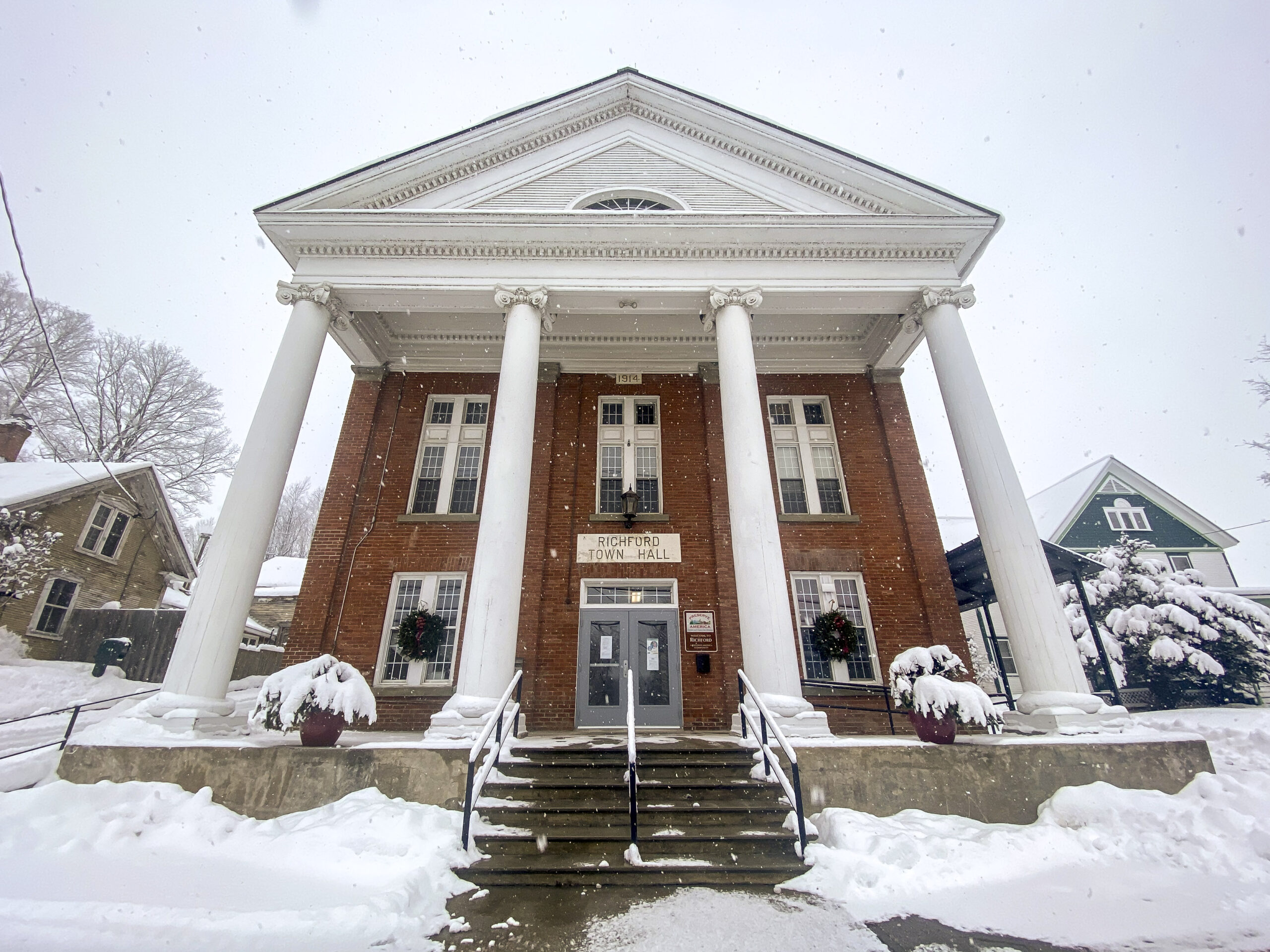CITY AND TOWN VOTERS TO DECIDE ON POOL, LOCAL OPTION TAX TODAY
By Gregory J. Lamoureux
County Courier
EDITOR’S NOTE: This news story was originally published in our Thursday, February 17th print edition. To stay up to date on Franklin County news, subscribe here.
ST. ALBANS: Town and City voters here will have what will be the costliest question on their ballot since the inception of the Collins Perley Sports Complex. Sure, school budgets are bigger values than the pool proposal, but as far as truly optional expenditures, the pool is likely to be at the top of the list for voters, at least in the past couple of decades.
During a meeting with voters, on Monday evening, City Manager Dominic Cloud said the money that the city would have to pour into its existing pool in order to keep it running doesn’t make financial sense.
“It may be the least expensive option,” Cloud said of rebuilding the existing pool but it’s not the most cost effective in the long term, he said.
Cloud said the City looked at other locations, including property where the current pool is, but the other properties didn’t pan out, or had significant negatives to building the pool there.
Whether it be the old Fonda location on Lower Newton Street, the existing location of the pool, or the current public works location, Cloud said they each had their own problems, and each one led officials to continue looking elsewhere.
For the current city pool location, Cloud said the parking is usually satisfied with the school’s parking lot, and that would likely be a major problem with a year-round pool.
Fonda had its own problems, including where to haul the dirt that would be removed from the property. And locating a new pool in the existing Public Works lot would eliminate much needed parking for the Little League fields, not to mention create another project- relocating the public works building.

The price tag for the pool comes in at $5.5 million, paid for with a bond, and bond payments would be paid using a local option sales tax, if it passes on Tuesday. That money will be split between town and city taxpayers, according to documents.
The last of three public meetings on the issue is slated for Monday evening at the Town Hall, near the Bay on Lake Road, in St. Albans Town. That meeting begins at 6:30 pm.
For the project to move forward, voters in St. Albans Town must approve only the pool on their ballot, but City voters have to approve the bond for the pool as well as a local option sales tax for the municipality.
If any of the three votes fail, the pool question will fail. If voters approve all three, officials hope to begin construction of the facility this spring, and have the pool open for visitors by the beginning of the swimming season next year.
So, what do voters get with the $5.5 million price tag? They get a pool with a zero-entry area, a diving board area, and a lap pool area. The project includes a pool house, inflatable dome for winter, and storage for the dome during the summer months.
Likened to the way a swimmer would enter the ocean or a lake, the zero entrance area of the pool would gradually slope into the water.
Cloud said the importance of having a zero entrance area for the pool is very important for those who are elderly or those who are very young and just learning to swim. It would allow elderly people who have trouble with steps to be able to access the water safely- even having an area with a railing for those who need it.

The new location for the pool would move it out of the City to the top of the hill at the Hard’ack Recreation area. For this reason, Cloud said the City would be implementing an “Aqua Bus” to transport youngsters, and adults if they wish, from the City and St. Albans Bay to the new pool location in an attempt to dispell concerns that the pool would no longer be located in an area of the City where lower income kids could easily access it.
The details of that bus, as well as longevity, are still up in the air. Cloud said they have not determined if they would be purchasing a bus that is handicapped accessible, or a less expensive option such as a large van, but said the city is prioritizing having bike racks on the bus so that kids could ride the bus up the hill to the pool, and ride their bikes back down the hill, if they wished, after swimming.
As for the longevity of the “aqua bus,” when Cloud was asked about its cost-effectiveness, he said they would give it a shot and see how it worked out, leaving open the option for getting rid of the bus if ridership didn’t satisfy officials.
As for ongoing costs to operate the pool, Cloud said they are working to make sure that usage fees pay for day to day operations, utilities, and upkeep.
“You’ll be able to pay a gate fee, or buy a membership,” Cloud told the voters as he assured them the City is trying to keep the fees as close to where they are now as possible

For a family pass, it would be about $35 a month, he said. $20 a month for an individual, or $5 at the gate if you don’t have a membership.
Those fees would be charged year round instead of just during the swimming season like they are with the current pool.
But operating a year-round pool comes with additional costs. Heating the water and dome will be one of the greatest costs, which is estimated to be around $180,000 per year in natural gas, according to Cloud. Then there’s the fee to have the dome installed in the fall and removed in the spring- around $25,000, and that cost was not clear during the Monday meeting.
Was it $12,500 each time the manufacturer of the dome came to install or remove it, for a total of $25,000 per year? Or was it $25,000 each time the manufacturer came, for a total of $50,000? One official thought it was the total, but couldn’t be sure when the question arose on Monday.
Staffing for the pool would be an added burden to the budget to operate, according to Cloud, and the City plans to hire a full-time manager for the facility, instead of having the Recreation Department manage it as it is now.
Cloud said the project would be paid for by a new local option sales tax, increasing the existing sales tax by one-percent throughout the City, preventing any increase to the municipal tax rate this year.

During Monday’s meeting, Cloud downplayed the possibility that voters would still be on the hook for the bond payment if something happens to the local option sales tax, but acknowledged that the possibility is there.
Cloud said the inception of a local option sales tax in the City would require a charter change from the legislature, which would be a binding document that would be difficult for the legislature to later back out on, not to mention most of the highly populated communities are going down that path, so it’s unlikely there would be political will to eliminate the law allowing for a local option sales tax in Vermont.
Although unlikely that the legislature could get rid of a local option sales tax, it’s possible too that voters in the city could later decide that they no longer want a local option tax- leaving the burden of the 20-25 year bond for the pool on the backs of property owners. The exact payment has not yet been determined because there are still too many variables, but Cloud said in Monday’s meeting that the payment for each municipality would likely be about $160,000 annually.
It happened in Killington a couple of years ago, when voters there decided that the local option sales tax was not working for them, so they removed it, leaving only the local option tax for rooms and meals in place but anything they had voted through up until that time still had to be paid for by local property taxpayers if it wasn’t picked up with the remaining portion of the local option tax.
Some municipalities have opted to only have their sales tax included in the local option tax, such as the City of Burlington. There you will pay an extra 1% when you buy a cutting board at Homeport, but across Church Street when you pick up a cup of Joe at Starbucks, you will still be paying the standard rooms and meals tax.

Cloud said it’s important to know what is taxed and what isn’t taxed as part of the extra one-percent, most of which would go into the City’s coffers.
Food at a grocery store isn’t taxed, and the additional one-percent will not apply to the purchase of vehicles or residential heating fuel, but if you have a property that is classified as commercial in St. Albans City, your heating fuel will see an additional one-percent tax, and it’s likely that will then be passed on to renters in the same rental properties.
What sort of utilities are taxed? According to Cloud, your cable bill is likely to be the only utility to see the additional one-percent tax.
But if you go out to eat a lot, you’ll see it there. And if you go to a bar in the City, you’ll see it there too.
Cloud said it’s almost impossible to know how much City residents will actually contribute to the local option tax. Statewide, the tax has been used to get money from out-of-town residents who spend money in your municipality.
For instance, maybe it will be a Fairfield resident coming into the City to have a pizza- or go to the bar. That Fairfield resident would be adding money to the City coffers with their purchase, but in some cases it may actually tax residents more if they live inside the City of St. Albans than if they live outside the City.

That’s because the tax is what’s called “destination-based.” The legislature did this to add the local option tax onto Internet orders like those that come from Amazon.
If you subscribe to a service online such as iTunes Music, Netflix, Hulu, or Amazon Prime, that too is a taxable purchase and will see the addition of the local option sales tax- as long as you are a City resident.
If you shop on Amazon a lot, or at another online-based retailer, you’ll be paying the extra one percent on every order shipped to your home or business in St. Albans City, but that same purchase just over the municipal border into Georgia wouldn’t have the extra duty added to it.
The law also applies to purchases made in St. Albans City but delivered outside the City. If someone purchases a ton of wood pellets from the St. Albans Co-op Store, and picks them up immediately, they’ll be paying the extra one-percent, or in that case a duty of about $2.40. But if they are delivered outside of the city, that local option tax doesn’t apply.

Of the $2.40 collected in the local option sales tax, the City would get about 70% of that money. The other 30% ends up being levied by the state in order to level the playing field for other communities.
The short answer is that the additional one-percent will apply to room and meals, alcohol, and any sales tax that is applied anywhere else.
One resident mentioned that it might increase the property values in and around the eastern part of St. Albans Town, and Cloud agreed. Though that also increases the final amount that those residents will pay in municipal and school property taxes.
Cloud likened the project to the ongoing Tax Increment Financing projects throughout the City.
The project is unlike anything else in northwestern Vermont, leading City and Town officials to believe that they will garner more support in the long run by having the pool as an attraction.
“If we build it, they will come,” Cloud said.







